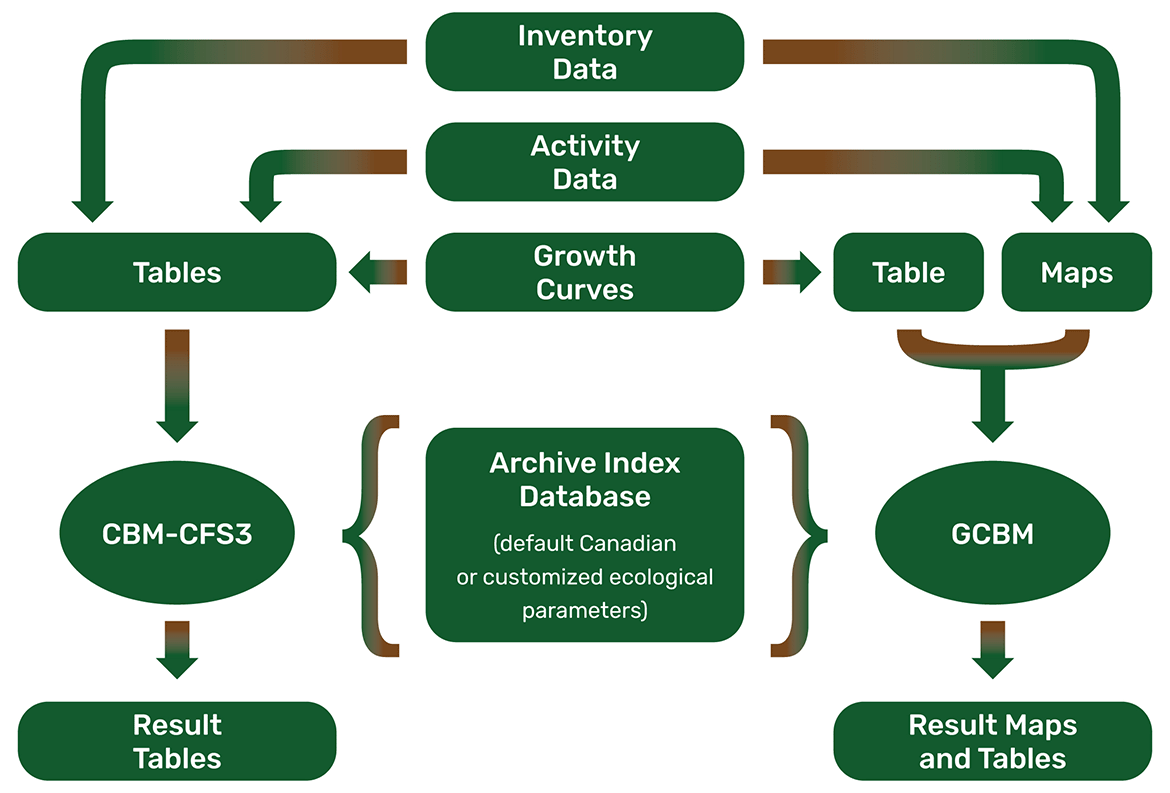Generic Carbon Budget Model
The Generic Carbon Budget Model (GCBM) is an open source, spatially explicit, stand and landscape-level modelling framework. The model produces a time series of spatial and tabular forest carbon indicators that users can visualize in the software of their choice. By enabling forest managers to consider the effects of their planned activities on forest carbon stocks and stock changes, application of the GCBM can potentially contribute to a reduction in greenhouse gas emissions.

The GCBM complies with the carbon estimation methods outlined in the 2003 Intergovernmental Panel on Climate Change (IPCC) Good Practice Guidance for Land Use, Land-Use Change and Forestry report and the 2006 IPCC Guidelines for National Greenhouse Gas Inventories. It simulates the dynamics of all forest carbon stocks required by the United Nations Framework Convention on Climate Change:
- aboveground biomass
- belowground biomass
- litter
- dead wood
- soil organic carbon
With the GCBM, users apply their own stand or landscape-level forest management information to calculate carbon stocks and stock changes for the past (monitoring) or into the future (projection). Users can also create, simulate and compare various forest management scenarios to assess impacts on carbon.
The model contains a set of default ecological parameters appropriate for Canada, which users can customize for application in other countries.
Unlike the Carbon Budget Model for the Canadian Forest Sector (CBM-CFS3), the GCBM contains modules that enable users to track and report on the amount of carbon in moss and peat pools.

Text version
Both the CBM-CFS3 and the GCBM require inventory data, activity data and growth curves from a user to create a project. The CBM-CFS3 requires these data in tabular format, while the GCBM requires the inventory and activity data in spatially-explicit maps.
Consequently, these data, along with ecological parameters in the Archive Index Database once simulated in either model, produces results tables for CBM-CFS3 projects, and results tables and maps for GCBM projects. Ecological parameters in the Archive Index Database for both models are Canadian by default, but can be customized.
GCBM results
Forest managers can use the GCBM to:
- create several projects for different forest management options, compare carbon results and select the plan that best meets their objectives
- observe the carbon results of forest management actions in individual stands and decide whether to apply those actions to an entire management area
- modify ecological parameters and climate data to assess potential future changes to ecological conditions in management areas
- analyze impacts of activities on emissions trends, nationally determined contributions (NDC), or natural climate solutions
Results can be used for various types of forest ecosystem carbon reporting requirements. In Canada, forest managers can use the model to report on forest carbon contributions to global cycles. This ensures compliance with sustainable forest management guidelines.
Results can also be used to report on forest carbon when applying for, or maintaining forest certification. Results can determine future carbon stocks and stock changes for forest carbon offset projects.
The GCBM will eventually replace the use of the CBM-CFS3 in Canada’s National Forest Carbon Monitoring, Accounting and Reporting System (NFCMARS), which is used for international reporting of the carbon balance of Canada’s managed forest. When using input data from NFCMARS, the Canadian Forest Service obtained virtually identical (<0.25% difference) estimates of carbon stocks and fluxes for Canada between the GCBM and the CBM-CFS3. The GCBM will support the future monitoring of natural climate solution outcomes such as those from the Government of Canada’s commitment to plant 2 billion trees.
Download the GCBM and self-guided training
The GCBM and a self-guided training package (English only) are available free for download from Canada’s National Forest Information System (NFIS) website.
If you have a NFIS account:
- select your jurisdiction and enter your account username and password
- after logging in, select a link on the Canadian Forest Service Carbon Accounting Tools page:
- GCBM version 1.0 is the latest version of the model and documentation
- click on the names of any file of interest to download
- Refer to Section 3.1.1 in the Operational-Scale Carbon Budget Model of the Canadian Forest Sector (CBM-CFS3) Version 1.2: User’s Guide for information on tabular import file requirements required by the GCBM for growth and yield data
If you do not have a NFIS account:
- click on the “Account Registration” button under the “New to NFIS” section
- create an account and profile
- Only the administrator of this website and select members of our forest carbon accounting team can view any information provided
- log in using your new account information
- Your login authorization and language selection will be stored using cookies
About the GCBM
The forest carbon accounting team at the Canadian Forest Service collaborated with Australian greenhouse gas (GHG) experts and the Linux Foundation to create the moja global project. This project has an open governance structure. The partnership was designed to:
- collaboratively manage the use and ongoing development of scientific models and tools
- respond to a growing need for forest carbon accounting models capable of processing large, spatially explicit datasets obtained through remote sensing technologies for land sector monitoring, reporting and verification
The GCBM is built on the same science as the aspatial CBM-CFS3 and is supplemented with information from national ecological parameter databases. The GCBM uses similar information required for forest management planning such as:
- forest inventory
- tree species
- growth and yield curves
- natural and human-induced disturbance information
- forest harvest schedule and land-use change information
However, the GCBM requires spatial inputs for forest inventory and disturbance area information. It does not have a graphical user interface. Users should have experience with python scripting and Windows® command line.
The GCBM can run on workstations, a computing cluster or the cloud. The model is open source. The largest ongoing challenge to GCBM application is developing the spatially explicit input data for future disturbance events such as wildfires and afforestation, due to the uncertainty about where and when these events may occur.
The GCBM was developed by recoding the existing science from the CBM-CFS3 into modules implemented on the FLINT platform, including:
- tree growth
- litter fall
- dead organic matter dynamics
- disturbances
In 2020, a release version of the GCBM, along with self-guided learning material that included a tutorial, was made available to the forestry community. Development of user documentation and other training materials is ongoing.
moja global
The GCBM is the forest carbon accounting software developed by the Canadian Forest Service to function on the Full Lands Integration Tool (FLINT) software platform developed by moja global.
moja global was established to develop open-source software tools for:
- mapping land-use change
- estimating and reporting GHG emissions and removals
- forecasting policy impacts on GHG emissions
- using land data for other policy priorities
moja global is tasked with:
- providing countries with reliable and freely available open-source software that is professionally managed to the standards of commercial software
- managing the development, testing, documentation and training for the software
- giving donors, developers and users a voice in the ongoing development and management of software tools through formal governance structures
- providing support for the implementation and use of the software in country-specific configurations
FLINT platform
National governments, multilaterals, non-governmental organizations, companies and individuals can be actively involved in the development and use of the FLINT and its modules (including the GCBM). Any organization, company or individual can participate in technical meetings and contribute to the tools. Different levels of participation exist, some requiring the signing of participatory membership agreements. Membership is not required for technical contributions such as:
- new coding
- new modules
- new science
To learn about moja global, the FLINT platform, the GCBM and participation options, a video series from a collaborative workshop between moja global and the United Nations Framework Convention on Climate Change is available on YouTube (in English only).
Have questions?
Please contact Stephen Kull if you:
- have questions about the GCBM
- require technical support with the model
- want to be notified about software releases or updates, training, webinars, new publications, etc.
Find out more
Related information
Page details
- Date modified: